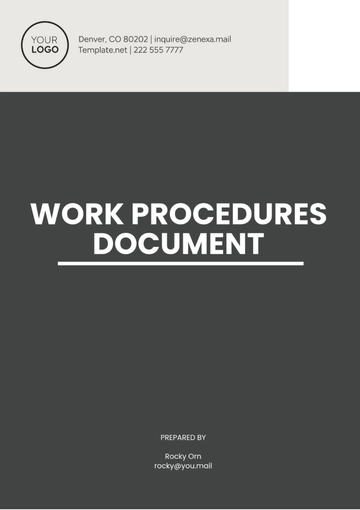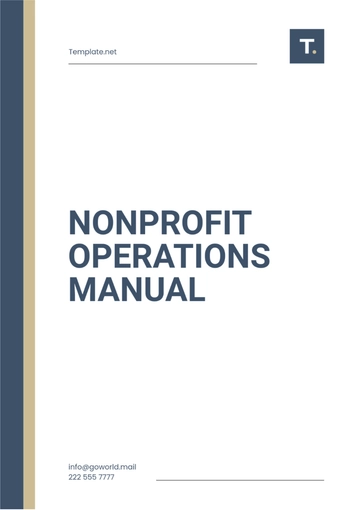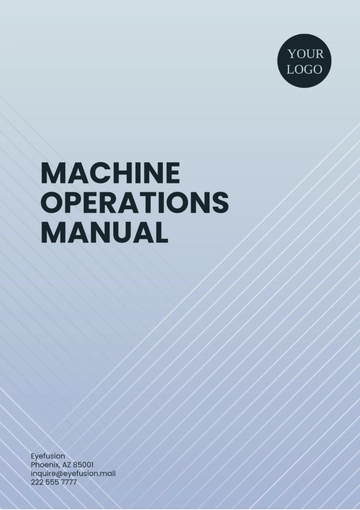Free Retail Operations Manual

I. Introduction
Welcome to the [YOUR COMPANY NAME] Retail Operations Manual, designed to provide comprehensive guidance on the day-to-day operations within our retail environment. This manual serves as a valuable resource for all employees within the[YOUR DEPARTMENT] department, ensuring consistency, efficiency, and excellence in our retail operations. By adhering to the guidelines outlined in this manual, you will contribute to the success and growth of [YOUR COMPANY NAME] as a leading retailer in the industry.
Within this manual, you will find detailed information on various aspects of retail operations, including customer service, sales techniques, inventory management, and store policies. Each section is carefully crafted to equip you with the knowledge and skills necessary to excel in your role and deliver exceptional service to our customers. As you navigate through this manual, feel free to refer back to it whenever you have questions or require guidance on specific procedures or protocols.
II. Employee Guidelines
A. Code of Conduct
At [YOUR COMPANY NAME] , we uphold the highest standards of professionalism and integrity in all our interactions with customers, colleagues, and stakeholders. As an employee of [YOUR COMPANY NAME] , you are expected to adhere to the following code of conduct:
Customer Service Excellence: Always prioritize the needs and satisfaction of our customers, providing prompt and courteous assistance at all times.
Professionalism: Maintain a neat and tidy appearance, communicate effectively, and demonstrate respect towards colleagues and customers.
Confidentiality: Safeguard sensitive information related to customers, colleagues, and company operations, ensuring confidentiality and privacy are maintained at all times.
B. Attendance and Punctuality
Punctuality is crucial to the smooth functioning of our retail operations. As an employee of [YOUR COMPANY NAME] , you are expected to:
Arrive at work on time for scheduled shifts.
Notify your supervisor promptly in case of any unavoidable delays or absences.
Adhere to the company's policies regarding requesting time off and obtaining approval in advance.
III. Customer Service
A. Greeting and Engagement
Creating a positive and welcoming atmosphere is essential for providing exceptional customer service. Here are some guidelines to follow:
Warm Greetings: Always greet customers with a friendly smile and welcoming demeanor as they enter the store.
Active Engagement: Approach customers proactively, offering assistance and guidance in finding products or addressing their needs.
Active Listening: Listen attentively to customers' inquiries and concerns, demonstrating empathy and understanding.
Product Knowledge: Stay informed about the products and services offered by [YOUR COMPANY NAME] providing accurate information to customers.
B. Handling Customer Complaints
Resolving customer complaints effectively is vital for maintaining customer satisfaction and loyalty. Follow these steps when handling customer complaints:
Listen attentively: Allow the customer to express their concerns fully without interruption.
Apologize: Apologize sincerely for any inconvenience or dissatisfaction experienced by the customer.
Resolve the Issue: Take appropriate action to address the customer's concerns, whether it involves replacing a product, offering a refund, or providing alternative solutions.
Follow-Up: Ensure that the customer is satisfied with the resolution and follow up as necessary to confirm their satisfaction.
IV. Sales Techniques
A. Upselling and Cross-Selling
Effective upselling and cross-selling techniques can significantly increase sales revenue and enhance the customer experience. Here are some strategies to implement:
Product Knowledge: Familiarize yourself with [complementary products] that may appeal to customers purchasing specific items.
Suggestive Selling: Politely suggest [additional products or services] that complement the customer's original purchase.
Benefits Highlighting: Emphasize the [benefits and value-additions] of upsell or cross-sell options to persuade customers to make additional purchases.
Personalization: Tailor your recommendations based on the [customer's preferences, needs, and budget] to enhance relevance and increase the likelihood of a sale.
B. Closing Techniques
Mastering closing techniques is essential for converting customer inquiries into successful sales transactions. Consider the following strategies:
Trial Closes: Throughout the sales process, subtly gauge the customer's interest and readiness to make a purchase through [trial closes], such as asking if they have any further questions or if they would like to proceed with the purchase.
Assumptive Close: Assume the sale by confidently guiding the customer towards the next steps, such as [confirming the quantity, size, or color] of the desired product.
Offer Incentives: Encourage immediate action by offering [limited-time promotions, discounts, or incentives] to motivate customers to finalize their purchase.
Overcoming Objections: Address any [concerns or objections] raised by the customer with empathy and provide reassurance or additional information to alleviate their hesitation.
V. Inventory Management
A. Stock Replenishment
Maintaining optimal inventory levels is essential to ensure product availability and meet customer demand. Follow these procedures for stock replenishment:
Regular Stock Checks: Conduct regular [stock checks] to assess inventory levels and identify items that require replenishment.
Reordering Thresholds: Establish [reorder points and reorder quantities] for each product based on historical sales data and demand forecasts.
Timely Reordering: Place orders with suppliers in a [timely manner] to prevent stockouts and minimize the risk of overstocking.
Vendor Communication: Maintain [open communication] with suppliers to address any issues or delays in the replenishment process and ensure timely delivery of orders.
B. Product Merchandising
Effective product merchandising enhances the visual appeal of the store and facilitates product discovery for customers. Consider the following merchandising principles:
Planogram Compliance: Arrange products on shelves according to the [designated planogram] to maintain consistency and maximize space utilization.
Visual Hierarchy: Create visual interest and draw attention to key products by employing techniques such as [color blocking, focal points, and signage].
Seasonal Displays: Refresh displays regularly to reflect [seasonal trends, promotions, or holidays], capturing customers' attention and encouraging impulse purchases.
Cross-Merchandising: Group complementary products together to encourage [cross-selling opportunities] and simplify the shopping experience for customers.
VI. Store Policies
A. Returns and Exchanges
Clear and consistent return and exchange policies are essential for managing customer expectations and ensuring satisfaction. Follow these guidelines:
Policy Overview: Familiarize yourself with the company's [return and exchange policies], including eligibility criteria, timeframes, and procedures.
Customer Communication: Clearly communicate the [return and exchange policies] to customers at the point of sale and provide them with a copy of the receipt for reference.
Documentation Requirements: Require customers to present [proof of purchase], such as a receipt or order confirmation, when requesting returns or exchanges.
Condition Assessment: Inspect returned items to ensure they meet the criteria for resale, such as being in [original condition with tags attached] and free from damage or wear.
B. Payment Procedures
Efficient and secure payment procedures are critical for facilitating transactions and protecting against fraud. Consider the following best practices:
Payment Methods: Accept a variety of payment methods, including [cash, credit cards, debit cards, mobile payments, and gift cards], to accommodate customer preferences.
Transaction Processing: Ensure that all transactions are processed accurately and promptly, verifying the authenticity of payments and maintaining compliance with [PCI-DSS standards].
Refund Processing: Process refunds promptly upon completion of return transactions, adhering to established procedures and providing customers with [confirmation of the refund].
Cash Handling: Implement strict protocols for cash handling, including [cash register reconciliation], depositing excess cash in secure locations, and limiting access to cash drawers.
VII. Safety and Security
A. Emergency Procedures
Preparedness for emergencies is essential to ensure the safety of customers, employees, and assets. Familiarize yourself with the following emergency procedures:
Evacuation Plan: Know the designated [evacuation routes] and assembly points in the event of a fire or other emergencies requiring evacuation.
Emergency Contacts: Maintain a list of [emergency contacts], including local authorities, medical facilities, and key personnel, and ensure that all employees are aware of how to access this information.
Emergency Equipment: Familiarize yourself with the location and proper use of [emergency equipment], such as fire extinguishers, first aid kits, and emergency exits.
Training and Drills: Participate in regular [emergency preparedness training sessions] and drills to ensure readiness and familiarity with emergency procedures.
B. Loss Prevention
Protecting against theft and minimizing losses is essential for safeguarding company assets and profitability. Implement the following measures:
Surveillance Systems: Utilize [surveillance cameras] and monitoring systems to deter theft and identify suspicious behavior.
Inventory Controls: Implement inventory control measures, such as [regular stock audits], security tags, and shrinkage analysis, to detect and prevent inventory losses.
Employee Training: Provide comprehensive training to employees on [theft prevention techniques], including recognizing signs of theft, handling shoplifting incidents, and following proper reporting procedures.
Customer Service Vigilance: Maintain a [vigilant presence] on the sales floor, offering assistance to customers and actively monitoring for any suspicious behavior or unauthorized activities.
VIII. Customer Service
A. Customer Engagement
Greeting Customers: Train staff to greet customers warmly and offer assistance upon entering the store, creating a welcoming atmosphere and fostering positive interactions.
Active Listening: Emphasize the importance of active listening skills in understanding customer needs and preferences, encouraging employees to ask open-ended questions and provide personalized recommendations.
Problem Resolution: Equip employees with the authority and resources to resolve customer complaints or issues promptly and effectively, empowering them to turn negative experiences into positive outcomes.
B. Feedback Collection
Surveys and Feedback Forms: Implement customer feedback mechanisms, such as surveys or feedback forms, to gather insights into customer satisfaction levels, identify areas for improvement, and measure the effectiveness of customer service initiatives.
Online Reviews Monitoring: Monitor online review platforms and social media channels for customer feedback and reviews, responding promptly to both positive and negative feedback to demonstrate responsiveness and commitment to customer satisfaction.
IX. Marketing and Promotions
A. Promotional Campaigns
Targeted Marketing: Utilize customer segmentation data to tailor promotional campaigns and offers to specific customer segments, maximizing relevance and effectiveness.
Multi-Channel Marketing: Implement integrated marketing strategies across multiple channels, including digital, social media, and traditional advertising, to reach customers at various touchpoints and drive engagement.
B. Sales Events
Seasonal Sales: Plan and execute seasonal sales events and promotions to capitalize on peak shopping periods and drive foot traffic and sales during key seasons.
Flash Sales and Limited-Time Offers: Create a sense of urgency and excitement by offering flash sales or limited-time offers on select products, encouraging impulse purchases and creating buzz around your brand.
X. Staff Training and Development
A. Onboarding
New Employee Orientation: Provide comprehensive onboarding programs for new hires, including training on company policies, procedures, and customer service standards, to ensure a smooth transition into their roles.
Product Knowledge Training: Conduct product knowledge training sessions to familiarize staff with the features, benefits, and specifications of products, enabling them to provide accurate and helpful information to customers
B. Continuing Education
Skill Development Workshops: Offer ongoing skill development workshops and seminars to help employees enhance their communication, sales, and problem-solving skills, fostering a culture of continuous learning and improvement.
Certification Programs: Encourage employees to pursue relevant certifications or professional development opportunities to expand their knowledge and expertise in their respective roles.
XI. Conclusion
In conclusion, the Retail Operations Manual serves as a comprehensive guide for [YOUR COMPANY NAME] employees, providing them with the tools and knowledge necessary to excel in their roles and contribute to the success of the business. By implementing the policies, procedures, and best practices outlined in this manual, employees can ensure consistent and efficient operations across all aspects of [YOUR COMPANY NAME] retail operations.
The Retail Operations Manual also emphasizes the importance of [STAFF TRAINING AND DEVELOPMENT], providing employees with ongoing opportunities for skill enhancement, career advancement, and personal growth. By investing in the continuous learning and development of its workforce, [YOUR COMPANY NAME] fosters a culture of excellence, innovation, and employee engagement, driving organizational success and competitive advantage in the dynamic retail industry.
- 100% Customizable, free editor
- Access 1 Million+ Templates, photo’s & graphics
- Download or share as a template
- Click and replace photos, graphics, text, backgrounds
- Resize, crop, AI write & more
- Access advanced editor
Introducing Template.net's Retail Operations Manual Template, the ultimate solution for streamlining retail processes. Fully editable and customizable, it empowers businesses to tailor operations to their unique needs. Edit effortlessly in our Ai Editor Tool, ensuring seamless integration of policies, procedures, and best practices for optimal retail performance.





























